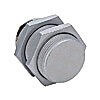The Pallet Puzzle
The puzzle factory cranked out 100 of their new giant floor puzzles and placed them on five pallets for shipping. The shipping clerk didn’t have the count for the individual pallets – but was told that there were 52 puzzles on the first two pallets, 43 on the second and third combined, 34 on the third and fourth, and 30 on the fourth and fifth. Can you help the clerk determine the quantity of puzzles on the individual pallets?

Did you know our FREE 2-day delivery for orders over $49 even applies to palletized shipments? If you order heavy or large/bulky items – we may recommend (or even require) that the shipment be sent via LTL freight, but our logistics dept and freight carriers still strive to get the products to you within two business days. Restrictions apply (we don’t guarantee our carrier’s performance) – please see our business policies for all the details.
Chain Gang
A chain factory has three chain making machines of varying capability. The first two machines can process a certain job in forty-five minutes. The first and third machines can process the same job in an hour, but the second and third machines require 90 minutes to complete that same amount of work. If all three machines were to tackle the job at once, how long would they take to complete it?
Lone Welders
The same factory also has three chain welding machines. Machines A and B can weld a given length of chain in 10 minutes. Machines A and C can weld the same length of chain in 9 minutes and machines B and C can weld it in 8 minutes. How long would it take each machine to weld that exact length by itself.

Didjaknow? We offer weld-slag resistant sensors in both standard and Factor 1 sensing with a special coating to reduce buildup of weld slag. These DC-powered (10-36V) harsh-duty inductive proximity sensors detect the presence of ferrous and other metallic objects. They have rugged stainless steel or brass threaded-barrels with LED indicators, and are available with 3m pigtail cables or quick-disconnects.
Answers Below
.
.
.
.
.
.
.
.
.
.
.
The Pallet Puzzle – The counts for the first, third and fifth pallets can be found by subtracting the “other” two distinct pairs of counts from 100. For example – the third pallet count is 100 – (52 + 30) = 18. Once those three are known the 2nd and 3rd are easy to deduce. From 1-5 respectively: 27, 25,18, 16, & 14.
Chain Gang – The first two machines can complete 1/45 of the job in a minute, the first and third complete 1/60 of the job in a minute, and the second and third only complete 1/90 of the job in one minute. Some algebraic substitutions reveal that the first machine can complete 5/360ths in one minute, the second 3/360ths, and the third 1/360th. Together they complete 9/360ths per minute – which completes the entire job in 40 minutes.
Lone Welders – Very similar math to the above: the machines A & B complete 1/10 of the job in a minute, A&C complete 1/9 of the job in a minute and B&C complete 1/8 of the job in a minute. So A by itself completes 49/720ths in one minute, or 14.7 minutes for the whole job. Machine B completes 41/720ths in a minute, or 17.6 minutes for the job, and machine C completes 31/720ths per minute – or 23.2 minutes for the entire run of the chain.

